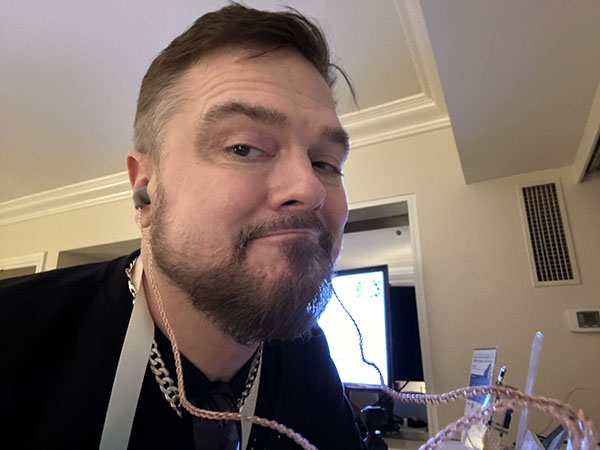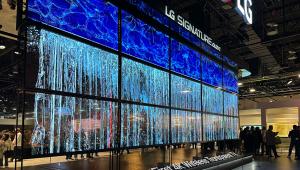CES 2024: Display Technology and Beyond with Mark Henninger and John Sciacca
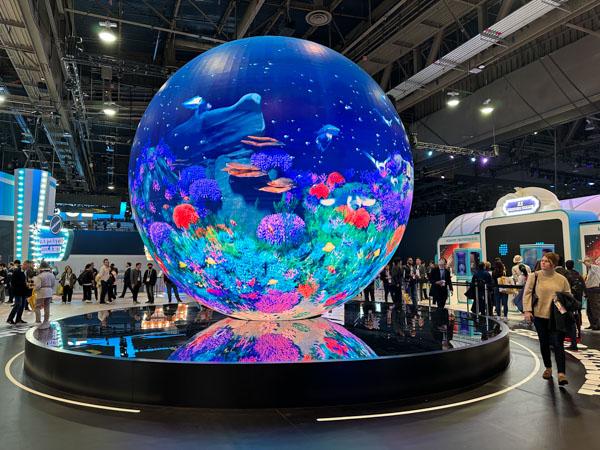
John and I examined display products from companies like Samsung, LG, TCL, Hisense, and Sony. We explored microLED technology, ultra short-throw projection, and the proliferation of large-format displays. Our discussion went beyond technical details to consider how these technologies apply in homes.
We also chatted about the future of audio and home theaters. Below is the full transcript (edited for clarity) reflecting on an industry that's seemingly always on the cusp of disruptive innovation.
Mark Henninger: Hi John, thanks for meeting up here at CES 2024. Samsung with the [modular] microLED wall was what I feel like what I've been waiting for, that absolute seamlessness. I went to the Samsung innovation room demo and they explained the three things they're doing, which amount to optically aligning the panels when they join them so that the pixels are the exact same distance from each other. The second being a calibration on the pixel level where the pixels meet, so that transition is seamless. The third is an anti-reflective coating on the edges of each tile so light doesn't catch it and reveal that grid.
John Sciacca: Hey Mark, nice to see you. I thought it was great and it does look good when it's showing regular content. But on the giant screen in front of the Samsung booth, when the panels are all white, you can really see the color mismatches and the grids. And I don't think people could live with that. I mean, some people could.
When you're talking that kind of money, you can't be seeing the grid structure and the white mismatch; it's gotta be perfect. And, from what I heard, I think there's still a lot of failure. So if you buy a huge microLED display, you're going to get so many extra tiles because they know some are going to fail. And that's part of the cost.
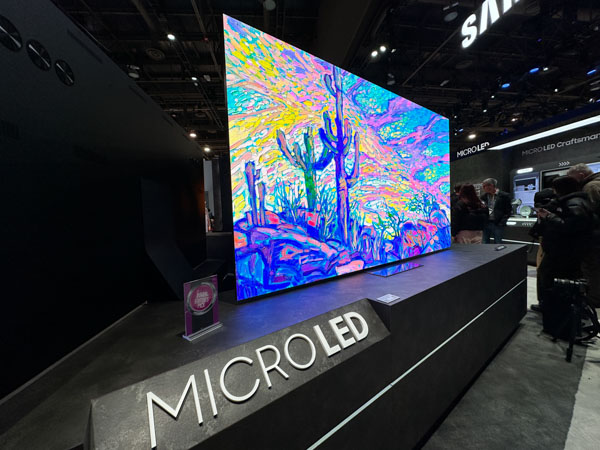
MH: Well, that's on the commercial side, but on the consumer side, nobody's pulling that screen apart and replacing a tile.
JS: Well, yeah, but I think it's the same panels. I mean, I think it's still commercial-ish...
MH: Yeah, it's based on the same tech. So what you're saying is, even if you start out perfect, you might not…
JS: I don't know anybody that's sold one. Not at a residential level, but what I've heard is that when you buy them, part of the cost is the support and also a large amount of replacement tiles. You can't just go out and get a new tile because it wouldn't be in the same color batch.
MH: That's not something they talk about, obviously, when they promote the technology. What about transparent TV? For some reason, everybody is getting into this transparent TV thing.
JS: I can see it in a commercial application. I don't really see what it does for residential.
MH: So here we are again, a display tech kind of being shown as if it was residential, but the reality is, yeah, what would you do with this?
JS: Other than maybe some kind of an ambient mode, I can't think why any of my customers would want that. I mean, it's kind of like if you build it, they will come. When you create something, you kind of build the use cases around it, right? So maybe people will think of some really cool things. I remember a few years ago, they showed display cases that could be transparent so you could overlay stuff in front of it like a smart display. I get it for that, but I just don't see what the residential application would be.
MH: Yeah, Samsung mentioned as they were showing the [transparent] TV to me that they're literally figuring out use case scenarios for it.
JS: And that [contrast] "curtain" going up and down on it, that just seems like another thing that could have a problem.
MH: It's mechanical. It makes an audible sound when it is operating, too.
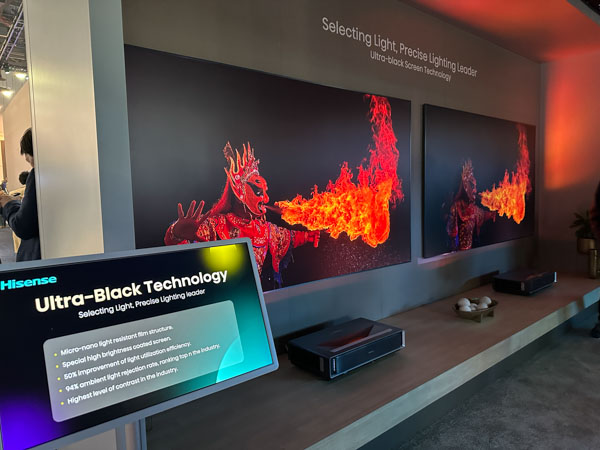
JS: Yeah. The other thing I noticed here at the show is the companies pushing ultra short-throw (UST) projection. But there are so many compromises. And to me, UST has all the compromises of regular projection with none of the benefits of a direct-view display. Like even over here in the Hisense booth, they've got their new 8K UST setup out in the open and it looks awful. I mean, we talk about how great black levels are, but you've got to have high brightness, too. I just don't think UST projectors are there yet.
MH: We're standing right next to 110-inch Hisense TV and I can see the UST over there, so it's pretty self-evident.
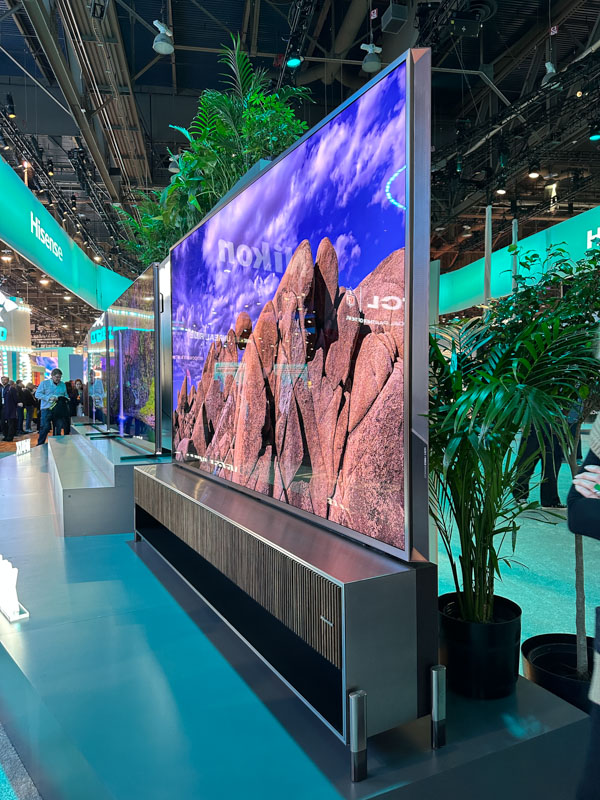
JS: It's one 10th of the brightness, if that. I mean…
MH: Yeah.
JS: But the other thing that I noticed, hand in hand with that, is I think the direct-view guys are pushing back against UST. You know, Hisense has 110-inch, TCL has 115-inch. It's like, "Hey, look, you want a big screen, we're obviously going big." At the Hisense press event, they said they are seeing an 18-fold increase in the sales of TVs with screens 85 inches and larger, last year to this year. The market is moving bigger.
MH: Big has become a thing because the pricing has become accessible for it. And at the same time, Hisense has a particular interest in ultra short-throw because they've been doing it for so long. So it's probably a well-established division within the company. So it makes sense that they're continuing to do it. But yeah, I would have to question what any of the other UST makers here would hope to accomplish when, as you said, TCL is right next door and they're not touching projection. They're just basically saying, "we're going to push 115 inches" and they've said it's going to cost under 20 grand.
JS: They also said it'd be over 10 grand.
MH: So over 10, under 20. Yeah.
JS: We have a range...
MH: We know where it's going to be. And that means that on a Black Friday, one can guesstimate that, yeah, maybe it'll touch that 10 grand price point.
JS: For a long time, I have been saying that if you could get a 100-inch direct-view for under 10 grand, that would be almost a projection killer. And now I know Sony's 98 incher is like $7,999 or something insane. We're getting bigger and less expensive — unless you're talking about multiple aspect ratios in a theater or a gigantoscreen and you don't have the money to go to microLED. I mean, the new mini-LED big screens are pretty phenomenal. Like the Hisense 110-inch—this TV looks amazing, to me. But, do you know what this is selling for? I don't have a price.
MH: I know that the middle TVs are the American models. So you don't have to buy it with the audio console underneath.
JS: I looked on the back, it had VESA mounts.
MH: Here we are standing and looking at the TV and you can see all these reflections in it. Samsung did something I really like: they put a matte coating on their quantum-dot OLED. I got to see it before the show but, unfortunately, they don't have it in their booth here. So the majority of attendees won't be able to have that experience. I would like to see a 110-inch screen with a matte finish on it.
That's not to say with the lights out that there would be any issue with a glossy screen finish. It would obviously take care of itself. But the matte finish would make images watchable in the living room. [If they can get rid of reflections in direct-view TVs], that's going to be the last nail in the coffin of UST because, as I've been saying, the one thing UST screens don't do is reflect. And you got wide viewing angles. But yeah, how can it compete against this [110-inch] TV)?
JS: Ultra short-throw, just because of the way projection technology works, never could compete. And, you know, part of the cost of UST is the screen. You know, a good screen, like a Stewart Black Diamond or one from Screen Innovations, could cost as much as the projector or more.
MH: You're very right. And right now those screens are pretty much topping out at 120 inches. So UST projection is not even giving you the advantages you get with [front] projection, which is go to 150 or 200 inches.
JS: Exactly. It's all of the drawbacks of projection, you know. You have to have a room dark, can't get true black levels, can't really do HDR — it's all of those things without the benefits. So every year, I feel like more and more people are showing the ultra short-throw. And every year I feel like the LED people make a better argument to "stick with us."
MH: What I didn't see at the XGMI booth was an ultra short-throw projector. What I did see was a, you know, a lifestyle projector that was actually quite powerful. So I'm thinking, one of the things that might come out of this ultra short-throw trend is the light engines that were developed for them are really gonna be repurposed in more conventional projectors.
JS: Take a portable, you carry it around, you know, take it on a trip, take it outside. I mean, it's great for that. I don't know that it's gonna be competitive with a true, dedicated theater projector, but, sometimes you just wanna grab it, put a movie on the garage door, or, you know, put it on a bedroom wall. There are a lot of applications that you don't need a $12,000 dedicated projector for.
MH: Even if you're in a living room and your walls are white, aren't you dead meat when it comes to the home theater projectors anyway? I mean, you can have a drop-down screen and you can have one of these and the difference of the black levels is not gonna be what it would be in a dedicated home theater. So I can see the use case for using DLP in a living room, whereas you're gonna use three-chip liquid crystal on silicon technology in that dark, dark room.
JS: I was impressed with what Sony showed us in the "black box room." They're kind of notorious for showing prototypes that may or may not ever happen, but those TVs looked fantastic. It's like all of the black levels of OLED with the much, much higher brightness of LED. It's as if TVs couldn't get any better and then somehow they seem to get better.
MH: I agree with you, that particular demo showed Sony's dedication to getting their TVs to be as close to a mastering monitor as possible, even in its default Standard picture mode. And yeah, the trick that they pulled off that we couldn't photograph was essentially cutting the TV in half and showing the backlight array on half the screen and the picture on the other half.
I agree with you that, you know, the argument they're making is that you're competing with OLED because LED can get brighter and this Sony is so devoid of those artifacts that the picture quality is good. I've been postulating that we're probably not gonna see giant OLEDs until they do inkjet at the sizes that we now have these LED TVs. It's really good to see the mini-LED backlights evolve.
JS: Yeah, I don't know… LG has an OLED that's what 97 inches or something. I mean, and it's 30 some thousand dollars. So, clearly that's not gonna have the play that LED is gonna have in the big, big screen sizes. So it's good that they are pushing that technology. But if you want a big size without an insane budget, mini-LED is gonna be the way to go.
MH: It must be more reliably easy to make the mini-LED panels without failure.
JS: I don't really know, there must be something with making that one giant sheet of glass of OLED, again I don't know. I'm just blown away by how great this Hisense 110-inch TV looks. I mean, I would take this in my living room every day of the week. In my living room, I have a screen that masks from 115 inches, 2.35:1 aspect ratio, down to a 92-inch 16:9. I could totally replace that with this, you know, and not feel sad about it.
MH: What's super obvious at this show is that there's nothing left that Hisense and TCL are not doing that previously LG and Samsung and Sony would have considered domain, other than OLED. They definitely do seem to have the mini-LED thing worked out.
JS: What I've noticed, especially the last couple of years, if you didn't know the TV industry and you just came here, you would really think that Hisense and TCL were the leaders. You go to Sony's booth, there's not a single TV. It's a small part of Samsung's booth. It's a small part of LG's booth. Panasonic has a brand new master series OLED that's not gonna be available in the States. It's like these guys are saying, hey, look, we have a brand new series of TVs, brand new technologies. It's definitely an unspoken statement or even a spoken statement that "TV's our focus," where it seems less so for the other guys.
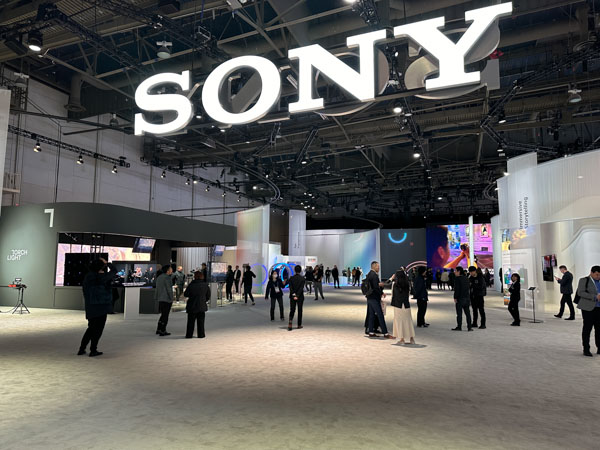
MH: Big time. The real surprise to me in the Samsung booth is that they are not even showing off what I would think to be the best TV they released this year — the matte screen quantum-dot OLED. And they're really interested in discussing sustainability, smart things, etc. in the abstract, while Sony isn't interested in any of that. They're like, "we make movies."
JS: Yeah, it's like, "this is for content creators, this is about PlayStation, and here's our car."
MH: Yeah, so Sony's TV demo was literally off-site and in a dark room. No photos and we're not really gonna show you any new models Sony has coming.
JS: And that's been the trend for them — they haven't had any consumer electronics in their booth at CES for the last three years.
MH: And now they've achieved the highest level where they're not even talking about it. But one would have to think that, as we stand here between TCL and Hisense, that this is part of the reason for it. That they've seen the need to move into a new category because the competition is so hard.
JS: Absolutely. Sony clearly and Samsung as well, they're at the premium end of the market. And that's a position that is getting harder and harder to stay in. Hisense said that they were the number one leader in mini-LED sales last year. There's probably a reason for that. If you want a mini-LED from Sony, you're buying their very, very top end model. Hisense said they're gonna have models this year under 400 bucks.
MH: That's true. A lot of consumers who bought a TV recently get upset because the prices are dropping so aggressively and the technology that gets put in at each price point is increases so fast that each year you're like, even if I bought a TV on Black Friday last year, they're putting that same tech in TVs a tier lower and, suddenly, the sale price becomes the regular price for a given level of performance.
JS: We've seen for years, you can't survive a race to the bottom. It's unsustainable. Obviously, these companies are able to hit price points you assume are profitable. But you can't continue to push the best technology and the lowest pricing, it's not a sustainable model. But again, year after year, these guys just continue to impress with what they're showing off.
MH: The other notable thing, though, is the openness of these booths versus the cloistered, you need an appointment...
JS: Yeah, the walled city of Samsung. I will say — I'm sure you've been in there — a huge theme of the show is AI [artificial intelligence]. Everyone's talking about it. But no one's really saying what AI is doing, just that they have it. But, Samsung has a video demo that shows their AI processing on and off. You know, it looked fantastic.
Again, you don't know what the source material is on the non-AI image but it looked incredibly soft. I think video processing is the unspoken hero in the TV world. The panels are probably a lot more similar than not. But it's the video processing that ultimately can make a big difference.
MH: Looking at that demo of the upscaling using the AI from Samsung, it struck me how it looked a lot like the newly processed James Cameron re-released movies, which have been treated and have upset the traditionalists or whatever. There is upscaling, grain removal, and detail enhancement. And so they look like different movies and it highlights an issue: Clearly, James Cameron's intent was this clean, digital looking movie that he couldn't make back then with film, but people think that the director's original intent of (for example) Aliens, is a gritty movie. So this AI upscaling had to my eyes the look of the James Cameron upscaling. And that to me says that, yeah, the new processing is pushing the envelope's edge of what the algorithms can do.
JS: We're not talking a film-based starting content, right? It was a video. So there was never any grain that was in it, but definitely, I mean, it looked sharpened. It looked sharper, you know? And for years, if you've been through ISF or THX training, you've had it beaten into your head that the sharpness button is like the devil, you know, never use it. But, people like a nice sharp image. And if you can do it without artifacts... To me, what it looked like is the old split screen images of before and after. And the before is dialed down. Like, I don't know that we were truly seeing two of the same images just being upsampled.
MH: That's what edge enhancement looks like though. It's very familiar to me because it resembles photographic upscaling in Photoshop. If you look at it, if you get very close to it, it starts to have a watercolor painting effect. But as soon as you step back past a threshold, what you see is the sharpness, the edge enhancement. So I would agree that I started seeing that a few years ago where processing became the most important element in pulling off all these tricks. And with OLED, they're putting heat sinks on the panels to get them brighter.
JS: Drive it harder, you know, get rid of the heat. Sony, that's been their mantra for years: "It's our processing." They came up with their cognitive reality processor a few years ago. So again, as computing horsepower becomes faster and cheaper, I mean, you can keep throwing more bits at it, you know, but potentially doing a better job.
MH: What readers, maybe everybody, understands at this point, is that AI models study huge data sets. And so, yeah, Samsung was saying that they have something like 100 servers churning through imagery to train its AI. It's largely the same thing as openAI does for chatGPT, but they're just doing it literally just for the video processor. Your firmware update basically gets the latest dump. So it's not even a static thing anymore — that's what AI is about. It's that you get this continuous improvement in the ability to recognize the elements and improve them.
JS: The other thing about the show is audio is all but gone now. I saw literally two audio products. SVS has a small booth on the floor and then McIntosh and Sonos Faber have a suite. I heard they put together a million dollar system for some sort of a flagship. Easily a million dollar system, easily.
MH: I went off-site to see Harman and they just had a tiny little nook, almost nothing. No announcements.
JS: Yeah, that Arcam stuff, though, looks really cool. The Radia series. I mean, those three components, they look cool and Harman certainly has got a ton of technology behind them.
MH: Speaking of Harman tech, they recently bought Roon. Did you see the Roon servers?
JS: Yes, because I'm familiar with them and had reviewed the one they had on display. I mean, I'm not sure what all the technical differences are on the new models. I saw them sitting there but nobody was there talking about them.
MH: That's because they haven't done any sort of a release on it, yet it's not under embargo.
JS: When I had talked to the guys that originally founded Roon, they felt like you would put it on your own computer and do it. I'm like, a lot of people don't want to have a dedicated computer or mess with it. They just want a piece of hardware they plug in. And so I think it was great for that and it'd be nice to see Harman build that into a luxury component that could go on a rack.
MH: I am predicting that we'll start to see more of those at audio shows.
JS: It'd be nice if they could. There's probably a Roon on a chip set with a hard drive built it into a server, right? Now that they own it, it seems like there are a lot of cool things they could do with it.
MH: Yeah, a lot of potential when it's owned by Harman and Samsung.
JS: Yeah, Samsung, ultimately, that's right. I mean, maybe we'll start seeing Roon in their TVs.
MH: Or in their phones.
JS: And your refrigerator (laughs).
MH: I do use Roon for pretty much all my at-home listening. I'm a big fan of that. What else? You have to travel offsite to even get any hi-fi audio at all other than SVS, although I got to give SVS credit. They're really going after the two-channel high-end.
JS: Yeah, that new speaker, it's the Prime Evolution.They're certainly going upscale. I'm gonna go back over there. I couldn't hear them when I was there the first time, but I have one of their subs. I've sold a lot of their speakers. Those guys give you a ton of bang for the buck. They kind of remind me of how Definitive Technology was back in the day, where you would get this just great value proposition, but now I think they're trying to deliver really high-end performance to go with it as well.
MH: It takes some guts, too, to just have a booth out here.
JS: This is their second year. Last year, if you remember, they were in between the black walls of Samsung and something else. You felt like you accidentally discovered them. Now they're out there. Gary (Yacoubian, SVS CEO and president) wants to support the industry, and for years, they'd been in a room in the Venetian. I don't know if you've been up to the Venetian Suites, it's a dead zone up there. There's nothing.
MH: There was Focal with new Aria Evo X speakers and xMEMS labs with new headphone stuff.

JS: I saw Victrola up there with some new turntables.
MH: Of course, Victrola, right.
JS: And Auro was up there.
MH: I did the Auro demo. Victrola, I have a soft spot for, even though some folks attack them — I mean, it's not like trying to relaunch Nakamichi. This is Victrola from an eternity ago.
JS: I happen to have their Stream Carbon. I reviewed it, and it's the first turntable I've ever owned, so I came into it with no agenda. It sounds great. It looks great. And the new ones with the UPnP and the Roon integration, they're really bringing a lot to the turntable.
MH: That's what I support — putting IP in there that really brings modern functionality, right, and it also looks nice.
JS: Yeah, it does. Most people who are buying a turntable now, I think are buying their first table, so to not have all the complexity — you need to have the balancing and the anti-skate — is huge. You want to be able to give somebody a quick three-minute video on how to set up the table and start enjoying music.
MH: Yes, I put it together and photographed it and used it, it was all really easy. And it photographed so nicely because it really does look that good.
JS: Yeah, the Carbon tonearm looks cool.
MH: xMEMS is something that might seem a little bit abstract to people, but in headphones, we're about a year away from new tech becoming dominant.
JS: It's not a market I follow a ton. I mean, what do you think is the new tech that's gonna be in headphones? I know spatial audio is the huge buzzword right now.
MH: Well, the XMEMS technology is a solid-state driver instead of a mechanical driver. So it's made the way same way chips are made.
JS: So they can be smaller?
MH: They're smaller and they are also much more consistent. So there's almost no variation between any two drivers, so you don't have to match them up, you're gonna have the same volume in each ear.
JS: So the quality control is gonna be better.
MH: Yes, and the tech that they were showing off at the prototype level, called Cypress — and this is something that sort of needs a graphic — creates bass by vibrating the driver at ultrasonic frequencies, and then a little port opens up and lets the air out, making deep bass. It's like there's a little pump in there. And it can actually outperform mechanical drivers that are trying to create that much bass. They mentioned the evolution of having such good bass capability in headphones is because noise cancellation requires it, countering the rumble of a jet engine, for example. It needs to be like 140 decibels down to 20 Hz to be effective.
JS: Is it in over-ear models? Is it in-ear models?
MH: They showed an over-ear two-way design where the xMEMS driver was used for the tweeter while a dedicated woofer handles bass. But the new Cypress tech is all about in-ears. It's a huge market. The stats say Apple makes more money off of AirPods than pretty much the rest of the audio industry does off speakers and amps and subs and headphones combined. Harman and Bose and Klipsch together do not add up to the money Apple makes from AirPods.
JS: We think we're so big until you see what real numbers are. And it's like, thanks guys. You guys are doing a good job.
MH: Yeah, I was also depressed to have the folks at Auro tell me about how AVRs are now just a replacement market. Too small really like to develop for. So yeah, they are doing soundbars.
JS: But you know what? Let Auro break into the U.S. first. Try to find some Auro content, you know?
MH: That's gonna be the challenge of course to get partners, right?
JS: They say disc market is dead. I mean, and you know, a lot of people would argue with that. You know, Oppenheimer sold out Like as soon as it came out. It's like, the disc market's "dead" but a lot of people still want discs. Try to find a disc that has an Auro-3D soundtrack on it. It just is not made in the U.S.
MH: They're gonna need a partnership with a streaming platform for their tech to be any sort of success. And so let me just segue that and say, Samsung's been working on their own open-source spatial audio with YouTube. How do you fight that?
JS: How do you fight Dolby? I mean, you know, everybody has a Dolby Atmos decoder at this point, or if not, at least a Dolby Digital decoder. It's like to make somebody switch fundamentally from what they're doing, you've got to be cheaper or better, right?
MH: Samsung is the only company that's ever bothered to fight Dolby with HDR10+ and not having Dolby Vision on its TVs.
JS: Which is a nothing burger. I mean, you know, as of right now. We'll see. It's tough to beat the massiveness of Dolby when it comes to streaming audio. DTS, they've been trying for a long time. Why is somebody going to switch from something that works, that everybody has? Sony's Bravia core service was going to support DTS:X, right? And I'm not even sure if that's still a thing.
MH: Because why bother?
JS: I don't know about why bother, I think it was just one of those things, there's just nobody using it.
MH: That's a tough road for Auro.
JS: It's an extra tough road. Although to be fair, the demo sounded great. They're showing that it can cover all kinds of bandwidth ranges without any pops or clicks or stopping.
MH: Well, then the only thing that would help them is if in streaming, they can absolutely prove that they can deliver quality at a lower bandwidth than somebody else, at scale.
JS: Yes, bandwidth costs money ultimately, so if you can do it as good or better in a smaller package…
MH: And like MQA technology, it may not ever have its own name attached to it when it finally comes to you. It could just fail and then get…
JS: Recycled into something else?
MH: Yes. Oh man, I don't mean to be mean to Auro.
JS: Have you been to the Stern pinball booth? They've got real props from the Jaws movie. They have a life-size Quint — I don't know what it's made out of. It's so incredibly realistic looking. Even close to it, it looks like a human being. It's insane. That's one of the things that's really fun about CES: I always feel like you're getting a glimpse into the future, right? You don't know how far away that future is, whether we're talking about haptic gaming or the simulation stuff — and we didn't even talk about car tech, or batteries — it's like you really feel like you're getting a glimpse down the road. We're seeing things today that people are gonna actually live with tomorrow.
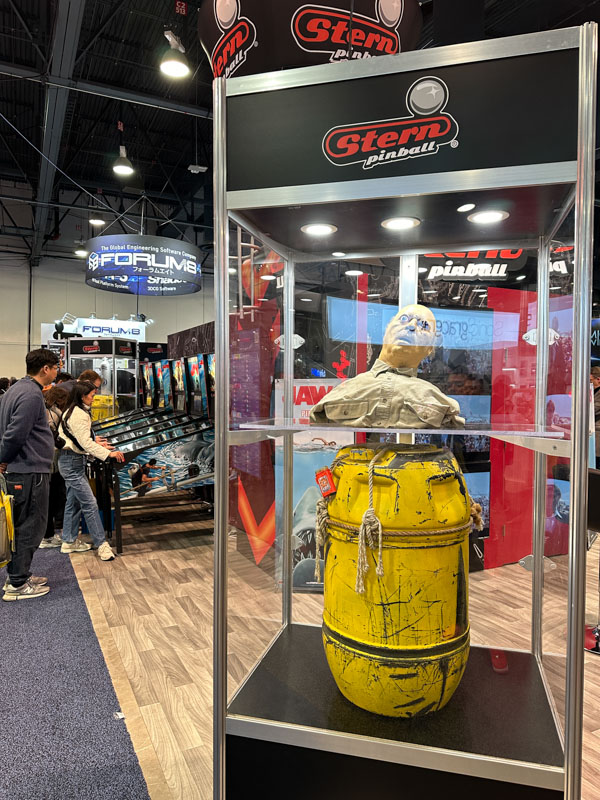
MH: That's the thing...with past CES shows the tech we saw is now fully manifest in these mature technologies that they're no longer promoting. That's what this show's about. Getting that taste of the future.
JS: TVs are such a tiny part of this show anymore. It's about the bigger world tech, you know, autonomous driving, green, solar, battery harvesting, aging in place technology, all of that big stuff that really matters.
MH: So as a wrap up, what do you think of the Hisense concept car with projectors in it?
JS: I'll tell you what, my wife's family lives in Alabama, it's a 10-hour car ride. If I could hit go, and then turn around and watch a movie for 10 hours, I am 1,000% for it. We'd go visit her family a lot more often.
MH: I love that. Maybe that's it. Autonomous driving becomes the gateway to having home theater experiences on the road.
